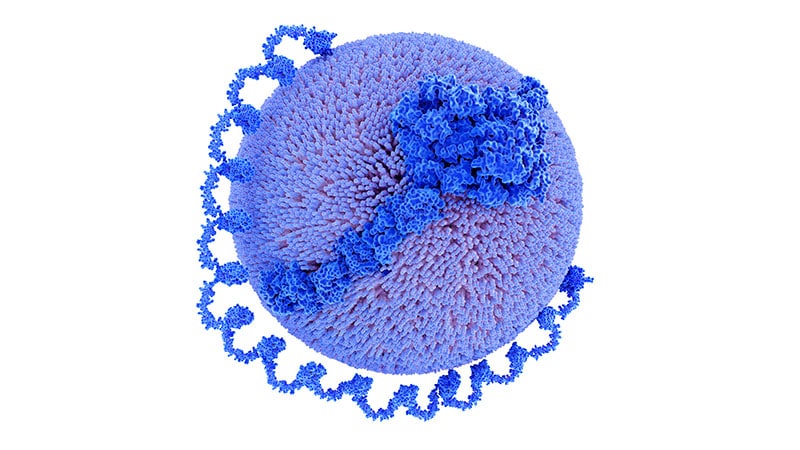Extended Data from APOLLO Phase 1 Trial Demonstrate Sustained Reduction in Lipoprotein(a) with Zerlasiran Treatment
מושגי ליבה
Zerlasiran, a short interfering RNA (siRNA) agent, produces a prolonged and significant reduction in lipoprotein(a) [Lp(a)] levels in adults with elevated Lp(a), including those with atherosclerotic cardiovascular disease (ASCVD).
תקציר
The extended data from the APOLLO phase 1 trial of the siRNA agent zerlasiran (formerly SLN360) showed sustained reductions in lipoprotein(a) [Lp(a)] concentrations out to 1 year in adults with elevated Lp(a).
The key highlights from the study are:
- Zerlasiran was well-tolerated, with no serious adverse events reported. Mild to moderate injection site reactions and transient elevations in C-reactive protein were observed.
- In healthy adults, a single dose of zerlasiran at 300 mg or 600 mg resulted in a median Lp(a) reduction of 30% and 29% respectively at 365 days.
- Two doses of zerlasiran at 300 mg or 450 mg administered 8 weeks apart led to a maximal median Lp(a) reduction of 98% in patients with ASCVD, which attenuated to 90% and 89% respectively after 201 days.
- The data suggest that a 300 mg dose of zerlasiran administered every 12 weeks (4 times per year) can produce a sustained 90%+ reduction in Lp(a) levels.
- Zerlasiran is one of several new therapies in development for elevated Lp(a), which is a major risk factor for premature atherosclerotic cardiovascular disease globally.
התאם אישית סיכום
כתוב מחדש עם AI
צור ציטוטים
תרגם מקור
לשפה אחרת
צור מפת חשיבה
מתוכן המקור
עבור למקור
www.medscape.com
Extended Zerlasiran Data Show Sustained Lp(a) Reduction
סטטיסטיקה
The median change from baseline in serum Lp(a) concentrations 365 days after single doses was:
+14% for placebo
-30% for 300 mg zerlasiran
-29% for 600 mg zerlasiran
The maximal median change from baseline after two doses was:
+7% for placebo
-97% for 200 mg zerlasiran
-98% for 300 mg zerlasiran
-99% for 450 mg zerlasiran
After 201 days, the median change from baseline was:
0.3% for placebo
-60% for 200 mg zerlasiran
-90% for 300 mg zerlasiran
-89% for 450 mg zerlasiran
ציטוטים
"Zerlasiran produces a prolonged reduction in Lp(a). This study was designed to determine how long it would work and what's the right dose."
"It turns out that there was almost no difference between the 300-mg and the 450-mg doses. That's important because you always want to use the lowest dose of a drug that will do the job. And we now know that we can give 300 mg, probably every 12 weeks — that's just four times a year — and produce 90+ percent reduction in Lp(a)."
תובנות מפתח מזוקקות מ:
by Megan Brooks ב- www.medscape.com 04-12-2024
https://www.medscape.com/viewarticle/extended-zerlasiran-data-show-sustained-lp-reduction-2024a10006zm
שאלות מעמיקות
How do the Lp(a) lowering effects of zerlasiran compare to other RNA-based therapies in development for elevated Lp(a)?
Zerlasiran, a short interfering RNA (siRNA) agent, has shown promising results in lowering lipoprotein(a) [Lp(a)] levels. Compared to other RNA-based therapies in development for elevated Lp(a), zerlasiran has demonstrated sustained reductions in Lp(a) concentrations out to 1 year, with maximal effects observed after two doses. The data from the APOLLO phase 1 trial indicate that zerlasiran can achieve up to a 98% reduction in Lp(a) levels, making it a potent and effective therapy for individuals with elevated Lp(a). Additionally, the extended follow-up data suggest that zerlasiran has a prolonged duration of action, with the right dose identified to produce significant reductions in Lp(a) levels.
What are the potential limitations or drawbacks of using a siRNA approach to target Lp(a) compared to other therapeutic modalities?
While siRNA therapies like zerlasiran show great promise in targeting Lp(a) and reducing its levels effectively, there are potential limitations and drawbacks to consider. One limitation is the need for repeated dosing, as seen in the trial where participants received multiple doses of zerlasiran to maintain Lp(a) reduction. This could pose challenges in terms of patient compliance and convenience. Additionally, the long-term safety profile of siRNA therapies is still being evaluated, and potential adverse effects may emerge with extended use. Another drawback is the cost associated with developing and administering siRNA therapies, which could limit access for some patients compared to traditional treatments. Furthermore, the specificity of siRNA targeting may raise concerns about off-target effects and unintended consequences on gene expression.
Given the high global prevalence of elevated Lp(a), what are the public health implications if zerlasiran and similar Lp(a)-lowering therapies are successfully developed and approved?
The high global prevalence of elevated Lp(a) levels, affecting approximately 20% of the population, underscores the significant public health implications of developing and approving therapies like zerlasiran for Lp(a) reduction. If zerlasiran and similar Lp(a)-lowering therapies prove to be successful, they could potentially address a major risk factor for premature atherosclerotic cardiovascular disease (ASCVD) on a global scale. By effectively lowering Lp(a) levels, these therapies have the potential to reduce the burden of ASCVD, prevent cardiovascular events, and improve outcomes for individuals at high risk. This could lead to a substantial decrease in healthcare costs associated with managing ASCVD and its complications, ultimately benefiting public health by promoting cardiovascular wellness and longevity.
0
